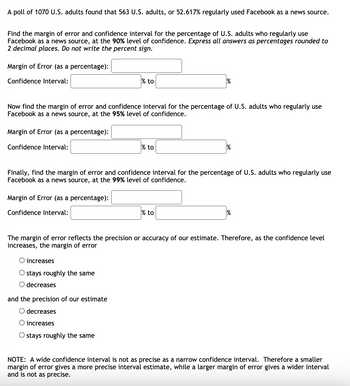
MATLAB: An Introduction with Applications
6th Edition
ISBN: 9781119256830
Author: Amos Gilat
Publisher: John Wiley & Sons Inc
expand_more
expand_more
format_list_bulleted
Question
thumb_up100%

Transcribed Image Text:A poll of 1070 U.S. adults found that 563 U.S. adults, or 52.617% regularly used Facebook as a news source.
Find the margin of error and confidence interval for the percentage of U.S. adults who regularly use
Facebook as a news source, at the 90% level of confidence. Express all answers as percentages rounded to
2 decimal places. Do not write the percent sign.
Margin of Error (as a percentage):
Confidence Interval:
Margin of Error (as a percentage):
Confidence Interval:
Now find the margin of error and confidence interval for the percentage of U.S. adults who regularly use
Facebook as a news source, at the 95% level of confidence.
Margin of Error (as a percentage):
Confidence Interval:
% to
O increases
O stays roughly the same
O decreases
% to
Finally, find the margin of error and confidence interval for the percentage of U.S. adults who regularly use
Facebook as a news source, at the 99% level of confidence.
and the precision of our estimate
O decreases
O increases
O stays roughly the same
%
% to
%
The margin of error reflects the precision or accuracy of our estimate. Therefore, as the confidence level
increases, the margin of error
%
NOTE: A wide confidence interval is not as precise as a narrow confidence interval. Therefore a smaller
margin of error gives a more precise interval estimate, while a larger margin of error gives a wider interval
and is not as precise.
Expert Solution
This question has been solved!
Explore an expertly crafted, step-by-step solution for a thorough understanding of key concepts.
This is a popular solution
Trending nowThis is a popular solution!
Step by stepSolved in 3 steps with 2 images

Knowledge Booster
Similar questions
- Need some Help!!arrow_forwardA new fertilizer was applied to the soil of 239 bean plants. 11% showed increased growth. Find the margin of error and 95% confidence interval for the percentage of all bean plants which show increased growth after application of the fertilizer. Round all answers to 2 decimal places. Margin of Error (as a percentage): Confidence Interval:arrow_forwardA poll of 2338 U.S. adults found that 71% regularly used Facebook as a news source. Find the margin of error and confidence interval for the percentage of U.S. adults who regularly use Facebook as a news source, at the 90% level of confidence. Round all answers to 2 decimal places. Margin of Error (as a percentage): Confidence Interval: % to % Find the margin of error and confidence interval for the percentage of U.S. adults who regularly use Facebook as a news source, at the 95% level of confidence. Round all answers to 2 decimal places. Margin of Error (as a percentage): Confidence Interval: % to %arrow_forward
- A poll of 2338 U.S. adults found that 71% regularly used Facebook as a news source. Find the margin of error and confidence interval for the percentage of U.S. adults who regularly use Facebook as a news source, at the 99% level of confidence. Round all answers to 2 decimal places. Margin of Error (as a percentage): Confidence Interval: % to %arrow_forwardFind the confidence level and α for an 86% confidence interval. What is the confidence level? Determine the value of α.arrow_forwardjust the multiple choice part thank you!arrow_forward
- Suppose you construct a 90% confidence interval for the true population mean GPA of students at Taft College. If all of the sample values remained constant and you decreased the confidence level, what would happen to the width of your confidence interval? Edit View Incortarrow_forwardHow do you find a 99 percent confidence interval?arrow_forward
arrow_back_ios
arrow_forward_ios
Recommended textbooks for you
 MATLAB: An Introduction with ApplicationsStatisticsISBN:9781119256830Author:Amos GilatPublisher:John Wiley & Sons Inc
MATLAB: An Introduction with ApplicationsStatisticsISBN:9781119256830Author:Amos GilatPublisher:John Wiley & Sons Inc Probability and Statistics for Engineering and th...StatisticsISBN:9781305251809Author:Jay L. DevorePublisher:Cengage Learning
Probability and Statistics for Engineering and th...StatisticsISBN:9781305251809Author:Jay L. DevorePublisher:Cengage Learning Statistics for The Behavioral Sciences (MindTap C...StatisticsISBN:9781305504912Author:Frederick J Gravetter, Larry B. WallnauPublisher:Cengage Learning
Statistics for The Behavioral Sciences (MindTap C...StatisticsISBN:9781305504912Author:Frederick J Gravetter, Larry B. WallnauPublisher:Cengage Learning Elementary Statistics: Picturing the World (7th E...StatisticsISBN:9780134683416Author:Ron Larson, Betsy FarberPublisher:PEARSON
Elementary Statistics: Picturing the World (7th E...StatisticsISBN:9780134683416Author:Ron Larson, Betsy FarberPublisher:PEARSON The Basic Practice of StatisticsStatisticsISBN:9781319042578Author:David S. Moore, William I. Notz, Michael A. FlignerPublisher:W. H. Freeman
The Basic Practice of StatisticsStatisticsISBN:9781319042578Author:David S. Moore, William I. Notz, Michael A. FlignerPublisher:W. H. Freeman Introduction to the Practice of StatisticsStatisticsISBN:9781319013387Author:David S. Moore, George P. McCabe, Bruce A. CraigPublisher:W. H. Freeman
Introduction to the Practice of StatisticsStatisticsISBN:9781319013387Author:David S. Moore, George P. McCabe, Bruce A. CraigPublisher:W. H. Freeman

MATLAB: An Introduction with Applications
Statistics
ISBN:9781119256830
Author:Amos Gilat
Publisher:John Wiley & Sons Inc

Probability and Statistics for Engineering and th...
Statistics
ISBN:9781305251809
Author:Jay L. Devore
Publisher:Cengage Learning

Statistics for The Behavioral Sciences (MindTap C...
Statistics
ISBN:9781305504912
Author:Frederick J Gravetter, Larry B. Wallnau
Publisher:Cengage Learning

Elementary Statistics: Picturing the World (7th E...
Statistics
ISBN:9780134683416
Author:Ron Larson, Betsy Farber
Publisher:PEARSON

The Basic Practice of Statistics
Statistics
ISBN:9781319042578
Author:David S. Moore, William I. Notz, Michael A. Fligner
Publisher:W. H. Freeman

Introduction to the Practice of Statistics
Statistics
ISBN:9781319013387
Author:David S. Moore, George P. McCabe, Bruce A. Craig
Publisher:W. H. Freeman